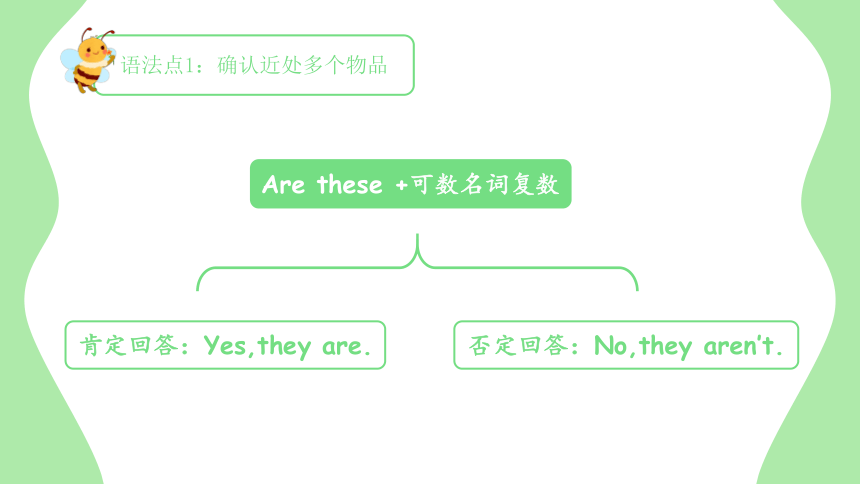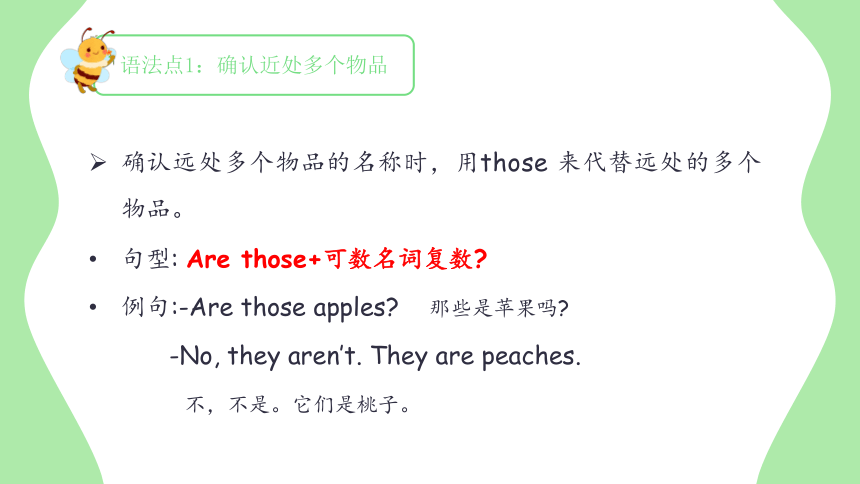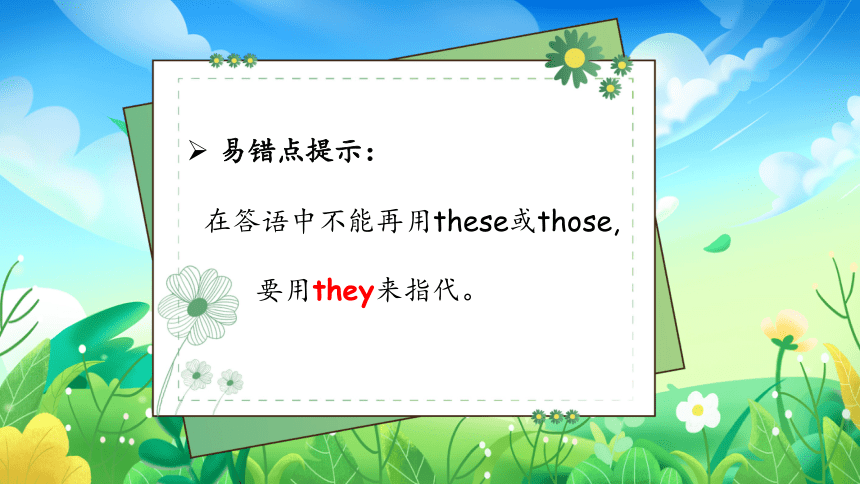Unit 4 At the farm 单元复习(四)-语法+典型例题(共52张PPT)
文档属性
| 名称 | Unit 4 At the farm 单元复习(四)-语法+典型例题(共52张PPT) |  | |
| 格式 | pptx | ||
| 文件大小 | 75.2MB | ||
| 资源类型 | 试卷 | ||
| 版本资源 | 人教版(PEP) | ||
| 科目 | 英语 | ||
| 更新时间 | 2025-03-11 15:42:03 | ||
图片预览












文档简介
(共52张PPT)
Unit 4
At the farm
语法过关
语法点1:确认近处多个物品
--Are these carrots 这些是胡萝卜吗?
--Yes,they are. 是的。
Are these tomatoes
这些是西红柿吗?
Yes,they are.
是的。
语法点1:确认近处多个物品
Are these +可数名词复数
肯定回答:Yes,they are.
否定回答:No,they aren’t.
语法点1:确认近处多个物品
确认远处多个物品的名称时,用those 来代替远处的多个物品。
句型: Are those+可数名词复数
例句:-Are those apples 那些是苹果吗
-No, they aren’t. They are peaches.
不,不是。它们是桃子。
易错点提示:
在答语中不能再用these或those,
要用they来指代。
温故知新
如何确认近处或远处某一事物的名称。
句型:-Is this/that+可数名词单数/不可数名词
-Yes, it is. / No, it isn't.
例句: -Is this the teachers office 这是教师办公室吗
-No, it isn't. 不,不是。
(四年级下册 Unit 1)
典型例题--我会选。
(1)--_______tomatoes
-- Yes, they are.
A.Are these B.Is this
(2)--Are these dogs
--No, _______.
A. they are B. these aren't C. they aren’t
A
C
语法点2:可数名词单数变复数的规则变化规律
不同情形 例词
一般情况直接+s book →books pen→pens
以-e结尾直接+s apple→apples orange→oranges
以-s;-sh;-ch;-x结尾的+es bus→buses watch→watches
以y结尾的将y变i+es family →families
以o结尾的,有生命的+es 无生命+s tomato →tomatoes
zoo →zoos photo→photos
以f或fe结尾的,将f或fe变 v+es leaf→leaves wife→wives
wolf→wolves knife→knives
典型例题--我会填。
写出下列单词的复数形式。
pear→_______ apple → _______
tomato→__________ boy→_______
library→_________ class→_______
pears
apples
tomatoes
boys
libraries
classes
语法点3:询问近处某些物品的名称
--What are these 这些是什么?
--They’re tomatoes. 他们是西红柿。
语法点3:询问近处某些物品的名称
What are these
这些是什么?
They’re green beans.
他们是豆角
问句句型:
What are these
答语句型:They’re+可数名词复数
易错点提示:
句中的these指代被问的多个物品。在
答语中不能再用these,要用they指代被
问的多个物品。而且表示事物名称
的名词要用可数名词复数。
温故知新
如何询问近处某一事物的名称。
句型 --What is this
--It's+a/an+可数名词单数.
例句: --What's this 这是什么
--It's a duck. (它)是只鸭子。
(三年级上册Unit 4)
典型例题--我会选。
1.--_______are these
--They're apples.
A.Where B. What
2.--_______ Are these pears
--______________.
A. No, they aren't. B. What are these C. Yes, they are.
B
B
A
语法点4:描述事物特征的句型
They are...描述事物的特征
句型:主语+be+(so)描述事物特点的形容词.
The giraffe is so tall.
这只长颈鹿这么高。
易错点提示:
在此句型中主语可以是代词,也可以是物品名称词。be 动词要随主语的变化而变化,当主语
是单数名词时,be 动词用is;当主语是复数
名词时,be 动词用 are。
例句:They are so cute. 它们这么可爱。
典型例题--我会选。
(1) Look at these apples.They____so big!
A.is B. are
(2)Look at the pig. It_____so fat!
A. is B. are
B
A
语法点5:a lot of 的用法
You have a lot of animals! 你有许多动物!
用法:a lot of 意为“许多的,大量的” 后跟可数名词复数或不可数名词
例句:There are a lot of birds. 有许多鸟。
There are a lot of milk. 有很多牛奶。
典型例题--我会选。
I have a lot of_____.
A. pencil B. pencils
B
典型例题--火眼金睛
找出下面这句话的错误之处,并改正。
There are lot of flowers in the garden.
A B C D
错误项:( ) 改正:__________
B
lots
语法点6:询问远处某些物品的名称
--What are those 这些是什么?
--They’re horses. 它们是马。
What are those 询问远处某些物品的名称。
语法点6:询问远处某些物品的名称
What are those
那些是什么?
They’re green beans.
他们是豆角
问句句型:
What are those
答语句型:They’re+可数名词复数
温故知新
询问远处的某个人/物的问句及答语
句型: --What's that
--It's+a/an+可数名词单数.
例句: --What's that 那是什么
--It's a panda.它是一只熊猫。
(三年级上册Unit4)
典型例题--我会选。
--What are those
--_____ pears.
A. Those are B. They are
B
语法点 7:询问对方拥有某事物的数量
--How many horses do you have 你有多少匹马?
--seventeen. 17匹
How many ......do you have
用来询问对方拥有某事物的数量
How many hens do you have
你有多少只母鸡?
Sixty. 六十只
问句句型:How many+可数名词复数+do you have
答语句型:I have +基数词
典型例题--我会选。
--____________________
--They are hens.
A. What is it B. What are those
B
典型例题--我会写。
写出下列单词的复数形式。
this→_________
that→_________
these
those
典型例题--我会连。
those, are, What( )
______________________________
What are those
易错点提示:
How many 后一定接可数名词复数。
回答的数词必须是表示数量的基数词。
语法点 8:What about… ”的用法
What about those 那些呢
What about …. 意为“……怎么样 ”,是口语中常用的句型。在对话中用来提出问题,连接下文。
例句: A:What are these 这些是什么
B:They are carrots. 它们是胡萝卜。
A:What about those 那些呢
B:They are tomatoes. 它们是西红柿。
典型例题--我会选。
--How many_________do you have
--Four.
A.dog B.dogs
B
典型例题--我会选。
选择合适的选项完成对话。
Amy: ________
Tom: Fifty.
Amy: Look!!________
Tom: They are sheep.
Amy: Oh.They are fat.________Are they sheep
Tom: No, they are goats.
A. What about those
B. What are these
C. How many ducks do you
have
C
B
A
语法点 9:Are they 确认多个事物
--Are they hens 它们是母鸡吗?
--No,they aren’t.They are ducks. 不,它们是鸭子。
Are they... 确认多个事物
Are they tomatoes
它们是西红柿吗?
No,they aren’t
不,它们不是。
肯定回答:Yes,they are.
否定回答:No,they aren’t.
Are they+可数名词复数
典型例题--我会选。
--Are they_________
--Yes,they are.
A.banana B.bananas
B
典型例题--我会填。
--_________ ducks
--No,they aren’t.
Are they
语法点 10:They’re 的用法
They’re...用来描述某些物品或人物名称
句型:They are+可数名词复数
They are ducks.
They are books.
典型例题--我会填。
Tom: Dad, are they hens
Dad:___________
Tom: Are they ducks then
Dad: ________
Tom:________
Dad: I have five.
C
A. How many ducks do you have
B. Yes, they are.
C. No, they aren't.
B
A
语法点 11:Look at 的用法
Look at the vegetables. 看这些蔬菜。
“Look at…”用来提醒他人看向某人或某物
Look at the dogs.
They are so cute
易错点提示:
当look at后跟人称代词时,要用宾格形式。
例句:Look at me. Am I cute
看我。我可爱吗
典型例题--我会选。
--Look_____ the dog
A.on B.at
B
温故知新
如何提醒他人看向某人或某物。
句型: Look at ...
例句:Look at me ! 看我!
(三年级上的 Unit 3)
语法点 12:love 与 like 的用法
-I love vegetables! 我喜欢蔬菜!
-I don’t like vegetables. 我不喜欢蔬菜。
love与like”表达喜欢某物或某人
句型:主语+love/like+事物/人.
例句: I like apples. 我喜欢苹果。
易错点提示:
1.当主语是单数第三人称时,表达某人喜欢某物或某人要用句型“主语+loves/likes+事物/人.”。
例句:Tom likes art. 汤姆喜欢美术。
2.当喜欢的事物是可数名词时,名词要用
复数形式。
语法点 12:love 与 like 的用法
表达不喜欢某物或某人句型主语+don'tlike+事物/人
例句: I don't like mutton.
我不喜欢羊肉。
易错点提示:
1. don't是 do not 的缩写,表否定。
2.当不喜欢的事物是可数名词时,
名词要用复数形式。
易错点提示:
3.当主语是第三人称单数时,表达不喜欢用“主语+doesn’t like+事物/人.”。doesn't
是does not的缩写,表否定。
例句:Tom doesn't like apples.
汤姆不喜欢苹果。
典型例题--我会填。
A.love B.loves C.doesn’t like
I________ fruit.
love
典型例题--我会填。
A.love B.loves C.doesn’t like
She___________ vegetables.
doesn’t like
典型例题--我会填。
A.love B.loves C.doesn’t like
She___________ meat.
loves
Unit 4
At the farm
语法过关
语法点1:确认近处多个物品
--Are these carrots 这些是胡萝卜吗?
--Yes,they are. 是的。
Are these tomatoes
这些是西红柿吗?
Yes,they are.
是的。
语法点1:确认近处多个物品
Are these +可数名词复数
肯定回答:Yes,they are.
否定回答:No,they aren’t.
语法点1:确认近处多个物品
确认远处多个物品的名称时,用those 来代替远处的多个物品。
句型: Are those+可数名词复数
例句:-Are those apples 那些是苹果吗
-No, they aren’t. They are peaches.
不,不是。它们是桃子。
易错点提示:
在答语中不能再用these或those,
要用they来指代。
温故知新
如何确认近处或远处某一事物的名称。
句型:-Is this/that+可数名词单数/不可数名词
-Yes, it is. / No, it isn't.
例句: -Is this the teachers office 这是教师办公室吗
-No, it isn't. 不,不是。
(四年级下册 Unit 1)
典型例题--我会选。
(1)--_______tomatoes
-- Yes, they are.
A.Are these B.Is this
(2)--Are these dogs
--No, _______.
A. they are B. these aren't C. they aren’t
A
C
语法点2:可数名词单数变复数的规则变化规律
不同情形 例词
一般情况直接+s book →books pen→pens
以-e结尾直接+s apple→apples orange→oranges
以-s;-sh;-ch;-x结尾的+es bus→buses watch→watches
以y结尾的将y变i+es family →families
以o结尾的,有生命的+es 无生命+s tomato →tomatoes
zoo →zoos photo→photos
以f或fe结尾的,将f或fe变 v+es leaf→leaves wife→wives
wolf→wolves knife→knives
典型例题--我会填。
写出下列单词的复数形式。
pear→_______ apple → _______
tomato→__________ boy→_______
library→_________ class→_______
pears
apples
tomatoes
boys
libraries
classes
语法点3:询问近处某些物品的名称
--What are these 这些是什么?
--They’re tomatoes. 他们是西红柿。
语法点3:询问近处某些物品的名称
What are these
这些是什么?
They’re green beans.
他们是豆角
问句句型:
What are these
答语句型:They’re+可数名词复数
易错点提示:
句中的these指代被问的多个物品。在
答语中不能再用these,要用they指代被
问的多个物品。而且表示事物名称
的名词要用可数名词复数。
温故知新
如何询问近处某一事物的名称。
句型 --What is this
--It's+a/an+可数名词单数.
例句: --What's this 这是什么
--It's a duck. (它)是只鸭子。
(三年级上册Unit 4)
典型例题--我会选。
1.--_______are these
--They're apples.
A.Where B. What
2.--_______ Are these pears
--______________.
A. No, they aren't. B. What are these C. Yes, they are.
B
B
A
语法点4:描述事物特征的句型
They are...描述事物的特征
句型:主语+be+(so)描述事物特点的形容词.
The giraffe is so tall.
这只长颈鹿这么高。
易错点提示:
在此句型中主语可以是代词,也可以是物品名称词。be 动词要随主语的变化而变化,当主语
是单数名词时,be 动词用is;当主语是复数
名词时,be 动词用 are。
例句:They are so cute. 它们这么可爱。
典型例题--我会选。
(1) Look at these apples.They____so big!
A.is B. are
(2)Look at the pig. It_____so fat!
A. is B. are
B
A
语法点5:a lot of 的用法
You have a lot of animals! 你有许多动物!
用法:a lot of 意为“许多的,大量的” 后跟可数名词复数或不可数名词
例句:There are a lot of birds. 有许多鸟。
There are a lot of milk. 有很多牛奶。
典型例题--我会选。
I have a lot of_____.
A. pencil B. pencils
B
典型例题--火眼金睛
找出下面这句话的错误之处,并改正。
There are lot of flowers in the garden.
A B C D
错误项:( ) 改正:__________
B
lots
语法点6:询问远处某些物品的名称
--What are those 这些是什么?
--They’re horses. 它们是马。
What are those 询问远处某些物品的名称。
语法点6:询问远处某些物品的名称
What are those
那些是什么?
They’re green beans.
他们是豆角
问句句型:
What are those
答语句型:They’re+可数名词复数
温故知新
询问远处的某个人/物的问句及答语
句型: --What's that
--It's+a/an+可数名词单数.
例句: --What's that 那是什么
--It's a panda.它是一只熊猫。
(三年级上册Unit4)
典型例题--我会选。
--What are those
--_____ pears.
A. Those are B. They are
B
语法点 7:询问对方拥有某事物的数量
--How many horses do you have 你有多少匹马?
--seventeen. 17匹
How many ......do you have
用来询问对方拥有某事物的数量
How many hens do you have
你有多少只母鸡?
Sixty. 六十只
问句句型:How many+可数名词复数+do you have
答语句型:I have +基数词
典型例题--我会选。
--____________________
--They are hens.
A. What is it B. What are those
B
典型例题--我会写。
写出下列单词的复数形式。
this→_________
that→_________
these
those
典型例题--我会连。
those, are, What( )
______________________________
What are those
易错点提示:
How many 后一定接可数名词复数。
回答的数词必须是表示数量的基数词。
语法点 8:What about… ”的用法
What about those 那些呢
What about …. 意为“……怎么样 ”,是口语中常用的句型。在对话中用来提出问题,连接下文。
例句: A:What are these 这些是什么
B:They are carrots. 它们是胡萝卜。
A:What about those 那些呢
B:They are tomatoes. 它们是西红柿。
典型例题--我会选。
--How many_________do you have
--Four.
A.dog B.dogs
B
典型例题--我会选。
选择合适的选项完成对话。
Amy: ________
Tom: Fifty.
Amy: Look!!________
Tom: They are sheep.
Amy: Oh.They are fat.________Are they sheep
Tom: No, they are goats.
A. What about those
B. What are these
C. How many ducks do you
have
C
B
A
语法点 9:Are they 确认多个事物
--Are they hens 它们是母鸡吗?
--No,they aren’t.They are ducks. 不,它们是鸭子。
Are they... 确认多个事物
Are they tomatoes
它们是西红柿吗?
No,they aren’t
不,它们不是。
肯定回答:Yes,they are.
否定回答:No,they aren’t.
Are they+可数名词复数
典型例题--我会选。
--Are they_________
--Yes,they are.
A.banana B.bananas
B
典型例题--我会填。
--_________ ducks
--No,they aren’t.
Are they
语法点 10:They’re 的用法
They’re...用来描述某些物品或人物名称
句型:They are+可数名词复数
They are ducks.
They are books.
典型例题--我会填。
Tom: Dad, are they hens
Dad:___________
Tom: Are they ducks then
Dad: ________
Tom:________
Dad: I have five.
C
A. How many ducks do you have
B. Yes, they are.
C. No, they aren't.
B
A
语法点 11:Look at 的用法
Look at the vegetables. 看这些蔬菜。
“Look at…”用来提醒他人看向某人或某物
Look at the dogs.
They are so cute
易错点提示:
当look at后跟人称代词时,要用宾格形式。
例句:Look at me. Am I cute
看我。我可爱吗
典型例题--我会选。
--Look_____ the dog
A.on B.at
B
温故知新
如何提醒他人看向某人或某物。
句型: Look at ...
例句:Look at me ! 看我!
(三年级上的 Unit 3)
语法点 12:love 与 like 的用法
-I love vegetables! 我喜欢蔬菜!
-I don’t like vegetables. 我不喜欢蔬菜。
love与like”表达喜欢某物或某人
句型:主语+love/like+事物/人.
例句: I like apples. 我喜欢苹果。
易错点提示:
1.当主语是单数第三人称时,表达某人喜欢某物或某人要用句型“主语+loves/likes+事物/人.”。
例句:Tom likes art. 汤姆喜欢美术。
2.当喜欢的事物是可数名词时,名词要用
复数形式。
语法点 12:love 与 like 的用法
表达不喜欢某物或某人句型主语+don'tlike+事物/人
例句: I don't like mutton.
我不喜欢羊肉。
易错点提示:
1. don't是 do not 的缩写,表否定。
2.当不喜欢的事物是可数名词时,
名词要用复数形式。
易错点提示:
3.当主语是第三人称单数时,表达不喜欢用“主语+doesn’t like+事物/人.”。doesn't
是does not的缩写,表否定。
例句:Tom doesn't like apples.
汤姆不喜欢苹果。
典型例题--我会填。
A.love B.loves C.doesn’t like
I________ fruit.
love
典型例题--我会填。
A.love B.loves C.doesn’t like
She___________ vegetables.
doesn’t like
典型例题--我会填。
A.love B.loves C.doesn’t like
She___________ meat.
loves
